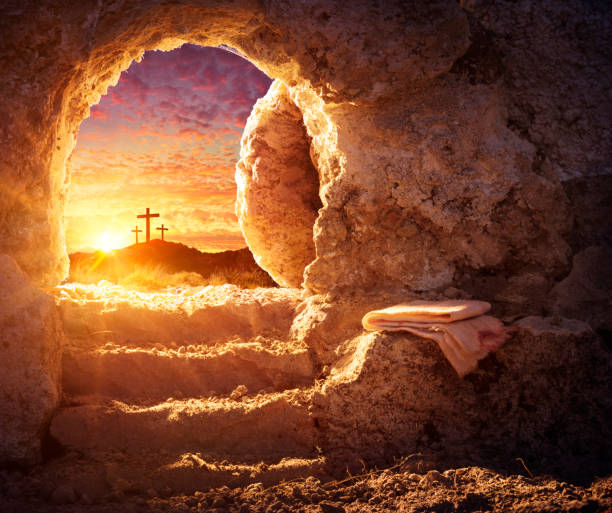The Gospel account of the women visiting the empty tomb of Jesus serves as strong evidence for the validity of the Resurrection, according to a popular pastor and podcaster.
In an episode of his podcast “Challenging Conversations” that aired Monday, Pastor Jason Jimenez talked about specific events described in the Gospels about the Resurrection of Jesus, including the women who visited the empty tomb.
“If you’ve never even considered taking a look at what actually happened, other than —yes the most important right? — that Jesus rose from the dead. But, how did these events fall into place, sequentially?” Jimenez asked his listeners.
Jimenez pointed out that in Scripture, a select group of women traveled to the tomb of Jesus on Easter morning, in Matthew 28:1, Mark 16:2 and Luke 24:1.
Jimenez said people will often claim that the verses about the women traveling to the tomb contradict one another. But, that is not the case, according to Jimenez.
“Already within this short little event, as [the women are] heading to the tomb, when you piece together the Synoptics, you see that they add a layer of detail, right? And it’s not that one misses a key point. Matthew, Mark and Luke were drawn to specific details to a specific audience,” Jimenez said.
“The great thing is when you take the Synoptics together collectively, they complement one another, right? And they feed one comprehensive narrative.”
When the women were going to the tomb, Jimenez said, it was before the start of the Sabbath. They had witnessed Jesus’ burial, which is another event that occurred on Easter, as demonstrated in Matthew 27:61, Mark 15:47 and Luke 23:55.
Jimenez noted that when the women walk to the tomb with their spices they say to one another, “Who will roll away the stone for us from the entrance of the tomb?” And looking up, they saw that the large stone had been rolled back.
The expectation that the women had was remarkable, the pastor emphasized, because the stone was believed to be well over 2,000 pounds, and yet they had faith that the stone could be lifted.
Jimenez said on average, the work to move the stone would have required up to 20 men to move and lift it, noting that with “the disciples who bailed on their Rabbi just a few days earlier, you only have 11.”
“This would take more than that. So, We don’t know what the women were thinking, how they will roll back the stone, what type of help they would have,” Jimenez continued.
“They had no plan. Not only that, but the women, remember, they hadn’t thought it through about the Roman guards that Caesar had placed there, it was under his seal.”
Jimenez talked about the angels in the passage that appear at the empty tomb, claiming that they were reminders to the women of what Jesus had told them about His resurrection.
“Jesus fulfilled prophecy and … that Jesus told us that He would die and then He would rise again, [and that] Jesus atoned for their sins,” Jimenez said, mentioning John 1:29. “He was the lamb of God. The perfect Lamb.”
The podcast host noted that “at that time in that culture, women were not credible eyewitnesses in the court of law,” and yet despite this, “the writers of the Gospels record that it was women who reported the tomb was empty to the disciples.”
“This reinforces the credibility of the Resurrection account. Because if in fact, this was a lie, it clearly would be mentioned, ‘the disciples in bravery went to the tomb to fight off the guards and to free the body of Jesus’ or that ‘they believe and they went in prayer under candlelight that Jesus had risen from the dead and they’re going to be there expecting Him and His resurrected body,’” he said.
“No. What we are told in Matthew, Mark, Luke and John that the disciples were not the first ones to be there, that they denied that Jesus rose from the dead. They weren’t even there expecting it. It was the women who had to go report this.”
The women found nobody because Jesus had risen from the dead, and they were afraid to tell people aside from the disciples because the angels told them to tell only the disciples.
“What’s amazing is, as the women were anticipating to tell this to the disciples, as they were going in a spirit of fear, because of what they just witnessed and it wasn’t making sense, and they were afraid that they were going to get caught on the way … but as they were going to get to the disciples, they began to remember the words of Jesus,” Jimenez said.
Jimenez said he found it amazing that it took the actions of women speaking up — who were not “the designated disciples” and that “society disregarded” — in order to compel the men to respond in faith.
“The credibility that authenticates this account, because it clearly brings about embarrassing narratives that give negative press towards the disciples because they weren’t there. The women had to come,” Jimenez said.
“Men, in the ancient Mediterranean world, didn’t trust women. Yet at some point, as the women trusted these angelic beings, and they were reminded of the teachings of Jesus, [the disciples] listened to these women.”







